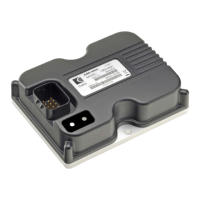24
Curtis 1352 eXm Manual, R ev. D
Store Parameters
Store Parameters controls when and if the changes made to a parameter (by
SDO Write) are backed up (stored) into EEPROM. An SDO read of Save All
Parameters sub-index 01h will return the present EEPROM Store Parameters
functionality (see Read data column). An SDO write to sub-index 01h will
change the EEPROM Store Parameters functionality (see Write Data column).
Note that when you write to Store Parameters, the data value is always
saved in EEPROM (even
NO_SAVE). This allows the eXm to power up in the
desired mode.
Store Parameters Function Write Read Description
Data Data
NO_SAVE 0 0 Device will not save parameter
changes to EEPROM.
SAVE_ON_COMMAND 1 1 Device will save changes
to EEPROM on command.
AUTO_SAVE 2 2 Device will save each change
to EEPROM automatically.
BOTH_SAVE 3 3 Device will save each change
to EEPROM automatically and
all parameters on a “save”
command.
SAVE_COMMAND “save” N/A Text string that commands all
65766173h parameters to be saved from
working RAM to Normal
runtime EEPROM.
BACKUP_COMMAND “bkup” N/A Text string that commands all
70756B62h parameters to be saved from
working RAM to the Backup
EEPROM.
For increased security, a text string is required for SAVE_COMMAND and
BACKUP_COMMAND. At first glance, the ASCII looks “backward.” This is
because CANopen defines that the LSB goes first and MSB is sent last. Therefore
“save” (which is data bytes 5, 6, 7 and 8) is written as “evas” when converting
it to hex (data bytes in proper descending order). The ASCII hex values for
each character are 65h (“e”), 76h (“v”), 61h (“a”), and 73h (“s”), which results
in hex 65766173h.
The “save” string will cause the eXm to write all RW parameters from
the working RAM locations into the normal runtime EEPROM locations. The
Normal EEPROM block is accessed during SDO write requests. The “bkup”
string will write into the secondary Backup EEPROM block. This block can
not be written to by normal SDO write requests and can only be written to in
bulk by the “bkup” command.
5 — SDO: Communication Profile Objects

